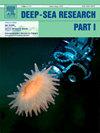A near field study of sediment plumes for a pre-prototype nodule collector trial in the abyssal Pacific Ocean
IF 2.1
3区 地球科学
Q2 OCEANOGRAPHY
Deep-Sea Research Part I-Oceanographic Research Papers
Pub Date : 2025-09-25
DOI:10.1016/j.dsr.2025.104595
引用次数: 0
Abstract
Observations from multi-platform monitoring of the sediment plume created during a pre-prototype deep-seabed nodule mining collector trial in the Pacific Ocean are presented and discussed. A combination of fundamental and geophysical fluid dynamics theory, as well as built-for-purpose numerical modeling, is used to interpret the observations. In turn, the implications of the interpreted observations for both monitoring and modeling of deep-seabed mining sediment plumes are considered. The observations occurred over a wide range of spatial and temporal scales, obtained through collector-mounted instruments within the mining area, instrumented moorings hundreds of meters away from the mining activity, and instrumented AUV operations at distances of hundreds to thousands of meters away from the test site. At each scale, interpreting plume observations is non-trivial because of the complexity of plume dynamics. Through interpretation of the observations, we exemplify the challenge of using plume monitoring or modeling alone in order to create a complete, non-ambiguous representation of the plume that is spatio-temporally resolved. Our analysis shows that an effective strategy that encompasses monitoring technology, deployment configuration, data interpretation, modeling approach, model parametrization, and model validation must be informed by plume physics at all levels. Furthermore, non-hydrostatic physics are instrumental to the evolution of plumes, and thus plume modeling for deep-sea mining sediment plumes needs to resolve non-hydrostatic processes.
太平洋深海结核收集器试验原型前期沉积物羽流的近场研究
本文介绍并讨论了对太平洋深海结核采矿收集器试验中产生的沉积物羽流的多平台监测结果。基础和地球物理流体动力学理论的结合,以及专门的数值模拟,被用来解释观测结果。反过来,解释观测对深海底采矿沉积物羽流的监测和建模的影响也被考虑。观测发生在广泛的空间和时间尺度上,通过采矿区内安装的采集器仪器,距离采矿活动数百米的仪器系泊,以及距离试验场数百至数千米的仪器AUV操作获得。在每个尺度上,由于羽流动力学的复杂性,解释羽流观测是非平凡的。通过对观测结果的解释,我们举例说明了单独使用羽流监测或建模的挑战,以便创建一个完整的、无歧义的羽流时空解析表示。我们的分析表明,一个有效的策略,包括监测技术、部署配置、数据解释、建模方法、模型参数化和模型验证,必须从各个层面上了解羽流物理。此外,非流体静力物理对羽流演化具有重要意义,因此深海采矿沉积物羽流模拟需要解决非流体静力过程。
本文章由计算机程序翻译,如有差异,请以英文原文为准。
求助全文
约1分钟内获得全文
求助全文
来源期刊
CiteScore
4.60
自引率
4.20%
发文量
144
审稿时长
18.3 weeks
期刊介绍:
Deep-Sea Research Part I: Oceanographic Research Papers is devoted to the publication of the results of original scientific research, including theoretical work of evident oceanographic applicability; and the solution of instrumental or methodological problems with evidence of successful use. The journal is distinguished by its interdisciplinary nature and its breadth, covering the geological, physical, chemical and biological aspects of the ocean and its boundaries with the sea floor and the atmosphere. In addition to regular "Research Papers" and "Instruments and Methods" papers, briefer communications may be published as "Notes". Supplemental matter, such as extensive data tables or graphs and multimedia content, may be published as electronic appendices.

 求助内容:
求助内容: 应助结果提醒方式:
应助结果提醒方式:


